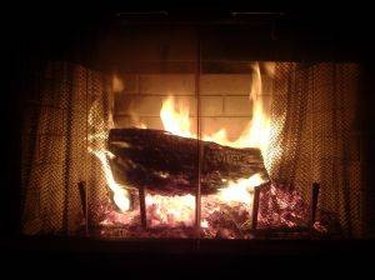
Fireplace Screens for Safety
Certain responsibilities come along with owning and operating a fireplace. The first and foremost concern should be safety. A fireplace screen will help ensure your fireplace is a safe place to burn wood. We all love to hear the snap, crackle and pop of the wood burning in the hearth; however, when we hear that it usually means that some small pieces of the hot or burning wood are being flung into the room. This is a potential fire hazard and can leave burns and stains on your wood or carpet flooring, or, worse, ignite a fire outside of the fireplace. The other use for a fireplace screen is to keep little children and other critters out. Children have a natural curiosity and like to investigate things they don't understand. Keeping a barrier between them and the fire can save little hands from getting burned.
Types of Screens
Video of the Day
There are many types of fireplace screens that will match any décor or fireplace. You can purchase them in various sizes or have them specially made for your fireplace. Most fireplace screens do not need to be installed since they sit in front of the opening to the fireplace. They come in three- and four-panel screens, surrounded in brass, copper and steel trim. The panels are hinged together for a custom bend around the opening. You can also purchase glass screens that sit in front of the fire giving you a better view. There are bowed screens and singe-paneled screens. You can purchase ornate screens and others decorated with your favorite football teams. To really beautify your fireplace, they are even made with stained glass. But the basic, safest and most popular screen is the fireplace spark-guard curtain. This type of screen does need to be installed and be in combination with glass doors or left by itself. The metal curtains keep the embers from flying out of the fireplace, are inexpensive and extremely durable.
Video of the Day
Installing the Curtain
The fireplace curtain comes as a kit and takes very little time or expertise to install. Measure and find the center of the fireplace lintel and place the center bracket on the lintel as far back from the face as you can. Mark the spot with a dark marker. Drill a hole at the mark using a 3/16 masonry drill bit until you have about a 1-inch hole in the masonry. Screw the center bracket into the lintel with a lag bolt if it's a masonry firebox or a metal screw if it's a metal firebox.
The rods come with flat ends and must be bent into a 90-degree angle using vice grips or pliers. This will allow you to attach the rod directly to the sides of your fireplace. The rod you are attaching to the right side will feed through the left side of the center bracket; the one that attaches to the left run through the right side of the bracket. If the rods are too long for your opening you can cut them down to 1 inch longer than the opening in the bracket. Mark the spot for drilling on the sides of your fireplace for the rods. Measure height and check level. Drill a 1-inch-deep hole on each side with the same-size drill bit. Thread the curtains onto the rods and run the ends of the rods onto the center bracket. Line the last ring of the curtain up with the hole for screwing the rods to the sides. Screw the rods onto the sides of the fireplace catching that last ring. This will keep the curtain from sliding into the center. The curtains should overlap each other in the center to close.